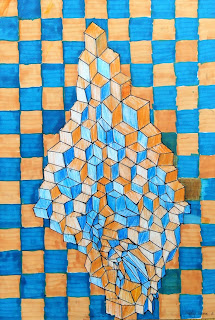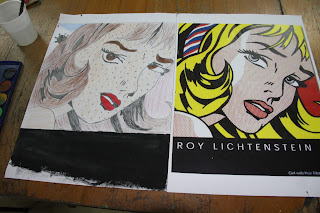Grade 7 students have been working super hard on these Pop-Art inspired portraits for their first unit of the year. Since this is the students' first year at the new school, and my first meeting with them, I needed to check their prior knowledge and wanted to give them a fun unit to start with at the same time.
As a prompt, we began by looking at Andy Warhol's work, and then at Pop Art/Pop Culture as a historical and contemporary movement. Students were able to do some of their own research and then we had a class discussion on color. We talked about Color Theory and the multitude of color schemes, then narrowed it down to the ones we wanted to focus on: Primary, Secondary, Tertiary, Complimentary, Analogous, Warm, Cool, Tints and Shades. We defined these schemes through class discussion/question and answer, and what colors were mostly used in the Pop Art movement.
Next we looked at what kinds of portraits were done in the Pop Art movement, and the students were so excited to see the Chairman Mao portrait by Warhol, since we are in China! It really brought together the global implications of Art, and how cross cultural it can be.
Students chose their favorite Pop Culture icon from today or historically from the internet, and I printed them out on A4 paper. They then did a plan in their sketchbooks so that they could work out the color schemes they wanted to use. According to the size of the portrait, they either did 2 or 4 portraits on one sheet of cardstock for their final, summative piece. They could choose a minimum of 2 color schemes, and up to as many as they wanted depending on the number of portraits they could fit on their final paper. Some students ended up with 12 portraits on one sheet!
Challenges:
Language/Vocabulary- It is hard enough to speak two languages, but add in a bunch of Art terminology, and that bar raises exponentially. The students did really well, though!
Time Management: From planning, to the final piece, this unit took nearly 10 weeks, plus a couple more classes for critique and assessment.
This unit went on waaaaay too long, and by the end, we were all ready to be finished. Even though some of them may not be considered " Pop Art", per se, there were some very interesting things happening at a purely aesthetic level, so I've include 1 or 2 of those. The struggle is real, but here are some images of their amazing work.






















































